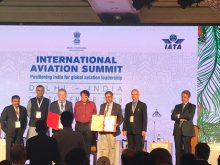 The International Air Transport Association (IATA), at International Aviation Summit held in Delhi, called on the government of India to maximise the potential contribution of aviation to India’s development by addressing infrastructure constraints that limit growth and government policies that impose excessive costs on aviation. Growth forecasts for India indicate a trebling of passenger demand by 2037 when some 500 million people are expected to fly to, from or within India. Already aviation supports 7.5 million Indian jobs and Rs 30 billion of GDP (1.5% of the economy). The Summit, being co-hosted by the Indian Ministry of Civil Aviation (MoCA), Airports Authority India (AAI) and IATA, commemorates the approaching milestone of 50-straight months of double digit domestic growth for Indian aviation.
The International Air Transport Association (IATA), at International Aviation Summit held in Delhi, called on the government of India to maximise the potential contribution of aviation to India’s development by addressing infrastructure constraints that limit growth and government policies that impose excessive costs on aviation. Growth forecasts for India indicate a trebling of passenger demand by 2037 when some 500 million people are expected to fly to, from or within India. Already aviation supports 7.5 million Indian jobs and Rs 30 billion of GDP (1.5% of the economy). The Summit, being co-hosted by the Indian Ministry of Civil Aviation (MoCA), Airports Authority India (AAI) and IATA, commemorates the approaching milestone of 50-straight months of double digit domestic growth for Indian aviation.
“While it is easy to find Indian passengers who want to fly, it’s very difficult for airlines to make money in this market. India’s social and economic development needs airlines to be able to profitably accommodate growing demand. We must address infrastructure constraints that limit growth and government policies that deviate from global standards and drive up the cost of connectivity,” said Alexandre de Juniac, Director General and CEO, IATA.
India’s aviation infrastructure has benefitted from significant upgrades in recent years. “It is clear that India has the capacity to develop effective infrastructure. But the job is not done. Passenger numbers will grow. And infrastructure must not be a bottleneck in fulfilling the needs of travelers and the economy,” said de Juniac who called for work in four priority areas – develop a comprehensive and strategic master plan for India’s airports, remove all obstacles to successfully opening Navi Mumbai as quickly as possible, modernise airport processes using technology in line with global standards and flexibly use military airspace to expand airspace capacity for civil operations.
Breaking News
- Domestic travel dominates as 58% of Indians opt for short trips in H1 2025, reveals Booking.com
- Skål International Delhi elects New Executive Committee, Homa Mistry is the new President
- India Travel Awards 2025 set to dazzle Delhi, recognising industry icons from tourism, hospitality
- Hospitality sector sees 12.9% RevPAR YOY growth in April-June quarter: JLL Report
- Odisha plans new conservation policy to bring 3,000 heritage monuments back to life: Deputy CM
- India can lead in sustainable tourism by integrating GSTC’s global criteria: Ramkumar
- Cross Hotels unlocked key opportunities at 3-city India roadshow of TravelBullz: Sandeep Raghav
- Indonesia’s Tourism Ministry partners with VFS Global to promote tourism under Wonderful Indonesia campaign
- Tier II, III cities and pilgrimage centres to drive hotel growth: CEO, Residency Group of Hotels
- Foreign trips to rise from 40 to 100 million in coming years, says Co-Founder, Pickyourtrail
- TGFI president calls for IATO partnership to safeguard India’s inbound tourism standards
 Tourism Breaking News
Tourism Breaking News


